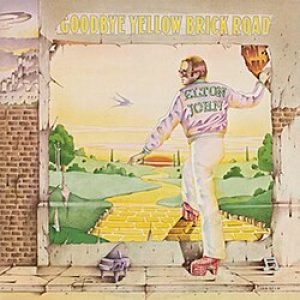By the time Goodbye Yellow Brick Road arrived in 1973, Elton John was already a major figure in popular music. With six studio albums behind him, he had proven himself as both a showman and a sensitive songwriter. This seventh album didn’t just follow that success—it expanded it. Clocking in at over 75 minutes and spread across two vinyl records, the album felt more like a musical statement than a typical release. It brought together the theatrical flair of his earlier work with a richer emotional palette and wider musical range.
Where previous albums like Honky Château or Don’t Shoot Me I’m Only the Piano Player hinted at Elton and lyricist Bernie Taupin’s storytelling ambitions, Goodbye Yellow Brick Road fully embraced them. Songs moved effortlessly from grand, sweeping rock operas to stripped-down ballads. Each track played like a scene in a larger, vivid narrative.
The album’s title and cover offer a clue to its vision. The yellow brick road, drawn from The Wizard of Oz, stands in as a metaphor for fame, fantasy, and the need to return to something more real. In that sense, the record touches on themes of disillusionment, longing, and the pull of simpler times. While not every moment hits with equal force, there’s a clear intent behind the variety: to create a body of work that reflects the highs and lows of both stardom and self-reflection.
Sonic Exploration

Goodbye Yellow Brick Road is a masterclass in studio production, especially for its time. Recorded at the Château d’Hérouville in France, the sound quality is rich and polished, allowing each track to breathe while still feeling cohesive as part of a larger work. The mix is clean without being sterile. Instruments have space to shine, from the dramatic swells of synthesizers to the subtle warmth of acoustic piano. Producer Gus Dudgeon strikes a balance between ambition and accessibility, never letting the studio techniques overwhelm the songwriting.
Musical Arrangements
Musically, the album is impressively diverse. The opener, “Funeral for a Friend/Love Lies Bleeding,” blends prog rock theatrics with hard rock energy. Its extended instrumental intro was ahead of its time, using synthesizers to build tension before the full band enters. “Bennie and the Jets,” meanwhile, plays with a faux-live sound, complete with crowd noise, creating a strange but compelling blend of glam rock and soul. It’s a playful, even risky move, yet it works within the album’s eccentric spirit.
The vocal and instrumental arrangements are also striking. Elton’s voice moves from tender and reflective on songs like “Candle in the Wind” to flamboyant and sneering on tracks such as “All the Girls Love Alice.” The backing vocals, often layered and gospel-tinged, add texture without clutter. Guitarist Davey Johnstone and drummer Nigel Olsson contribute to arrangements that feel both precise and expressive, particularly on tracks like “Saturday Night’s Alright for Fighting,” which charges forward with gritty, bar-band energy.
Genre Elements
Genre-wise, the album is a mosaic. Glam rock, soft rock, pop balladry, soul, country, and even touches of reggae all make appearances. Rather than committing to a single genre, Elton and Bernie let each song dictate its own identity. While this could risk making the album feel scattered, the strong songwriting and thematic cohesion keep it grounded. The result is not just a variety show but a musical journey that feels adventurous yet intentional.
Lyrical Analysis

At the heart of Goodbye Yellow Brick Road lies a deep sense of nostalgia and reflection. Bernie Taupin’s lyrics often read like diary entries—personal, poetic, and rich with imagery. Across the album, there’s a consistent pull between the glitz of fame and the yearning for something more grounded. The title track captures this tension perfectly, telling the story of someone who longs to abandon the bright lights and return to simpler roots. It’s not just about escaping fame, but about reclaiming identity.
Themes of lost innocence, self-doubt, and longing run throughout. In “Candle in the Wind,” Taupin paints a heartfelt portrait of Marilyn Monroe, framing her as a symbol of vulnerability beneath celebrity. That same emotional honesty surfaces in “I’ve Seen That Movie Too,” which speaks to the pain of betrayal with cinematic flair. Even the more upbeat songs, like “The Ballad of Danny Bailey,” carry a bittersweet tone, reflecting on life’s darker edges through a storytelling lens.
The lyrics range in complexity. Some are direct and narrative, like “All the Girls Love Alice,” which tells the tragic story of a teenage runaway in a bold, unflinching way. Others lean into metaphor, leaving more room for interpretation. “This Song Has No Title,” for instance, feels like a moment of artistic self-doubt wrapped in poetic vagueness. Taupin’s gift lies in his ability to balance accessibility with depth—his words are often simple in structure, but layered with meaning.
Emotional Impact
Emotionally, the album is wide-ranging. It touches on sadness, longing, and regret, but never falls into melodrama. The lyrics feel sincere, often inviting listeners to reflect on their own experiences. Whether it’s the heartbreak of fading dreams or the high of youthful rebellion, the songs resonate because they come from a place of truth. Combined with Elton’s expressive delivery, the words take on a powerful emotional weight.
Cohesion and Flow

For a double album that spans 17 tracks, Goodbye Yellow Brick Road is remarkably cohesive. While its musical styles vary widely—from glam rock and soul to gentle ballads and country-folk—there is a thoughtful structure beneath the surface that helps the songs flow naturally. The album opens with the grand and theatrical “Funeral for a Friend/Love Lies Bleeding,” setting a tone of drama and emotional weight. This transitions into lighter fare like “Candle in the Wind” and “Bennie and the Jets,” offering a kind of emotional breathing room early on.
As the record unfolds, it shifts smoothly between moods and genres. There is a sense of deliberate pacing in how upbeat and slower songs are arranged. Tracks like “Saturday Night’s Alright for Fighting” inject bursts of energy, while more introspective moments, such as “Harmony” or “Roy Rogers,” provide contrast without feeling out of place. This variation adds depth and prevents the album from becoming monotonous, even as it stretches over an hour.
Thematic Consistency
Thematically, the album holds together with surprising strength. The central ideas—nostalgia, disillusionment, fame, and the search for authenticity—surface in different forms throughout. Even when the sound changes, the emotional undercurrents remain steady. Whether it’s the personal lament in “Goodbye Yellow Brick Road” or the fictional storytelling in “The Ballad of Danny Bailey,” each track contributes to a broader exploration of identity and desire.
There are moments, particularly in the second half, where the cohesion loosens slightly. A few tracks could be seen as filler or less essential, and their placement may not always support a strong narrative arc. However, these dips are brief and do little to detract from the overall impact. The album still feels like a unified body of work, guided by Elton John’s voice and Bernie Taupin’s lyrical vision.
Standout Tracks and Moments
While Goodbye Yellow Brick Road is full of strong material, several tracks stand out for their artistic power, emotional weight, or inventive flair.
Goodbye Yellow Brick Road
The title track, “Goodbye Yellow Brick Road,” is a clear centerpiece. Its gentle melody and yearning lyrics strike a universal chord, capturing the heart of the album’s themes—disillusionment, escape, and the search for something real. Elton’s falsetto in the chorus adds a layer of fragility, making it one of his most emotionally resonant performances.
Bennie and the Jets
“Bennie and the Jets” remains one of the album’s most iconic moments, in part due to its bold production choices. The song’s fake live sound, complete with crowd noises and echo effects, was a creative gamble that paid off. It gives the track a surreal, theatrical quality that matches its subject—a futuristic glam rock star—with playful energy.
Candle in the Wind
Another standout is “Candle in the Wind.” Originally written as a tribute to Marilyn Monroe, the song delivers a quiet, enduring sadness. The lyrics are simple but piercing, and Elton’s restrained vocal performance makes the emotion all the more potent. It’s a ballad that speaks to vulnerability and myth, without becoming overly sentimental.
Funeral for a Friend/Love Lies Bleeding
“Funeral for a Friend/Love Lies Bleeding” deserves mention for its sheer ambition. Opening the album with an extended instrumental was an unusual choice, but it works brilliantly. The synth-driven prelude slowly builds tension, leading into a rock anthem that bursts with intensity. This track alone showcases the band’s range, from cinematic soundscapes to raw power.
Memorable Moments
There are also subtler moments that shine. “Harmony,” the album’s closer, ends things on a bittersweet note. Its smooth vocal layering and gentle rhythm offer a final reflection that feels earned. In contrast, the gritty guitar riff in “Saturday Night’s Alright for Fighting” injects a rush of adrenaline, reminding listeners of Elton’s rock credentials.
Artistic Contribution and Innovation

At the time of its release, Goodbye Yellow Brick Road stood as a bold artistic statement in the landscape of early 1970s rock. The album arrived during a period when rock was becoming more theatrical and ambitious, yet few artists managed to combine mass appeal with genuine artistic risk the way Elton John did here. Rather than settling into a single style, he and lyricist Bernie Taupin used the double album format to explore a wide emotional and musical range—something that was still relatively rare outside of progressive rock circles.
In terms of genre, the album doesn’t sit neatly in one category. It touches on glam rock, pop, balladry, country, and soul, often within the same side of the record. This refusal to stay in one lane was both daring and forward-thinking. While some albums of the era leaned heavily into concept or sonic uniformity, Goodbye Yellow Brick Road embraced variety, using strong songwriting and lyrical cohesion to hold everything together. That approach helped redefine what a pop-rock album could look like—not just a collection of hits, but a complete and evolving musical experience.
Innovation
From a production standpoint, the album also broke new ground. The decision to open with a long, instrumental-heavy suite like “Funeral for a Friend/Love Lies Bleeding” was a risk that paid off. It signaled right away that the listener was in for more than just radio-friendly singles. Tracks like “Bennie and the Jets,” with its artificial live feel, played with perception and presentation in a way that felt fresh and unexpected.
Lyrically, Taupin’s storytelling was a standout. While much of pop music in the early 70s was still driven by love songs or simple hooks, Goodbye Yellow Brick Road wove cinematic narratives and character studies into its structure. The album tackled fame, identity, gender, and emotional vulnerability without feeling preachy or self-important. Its ability to address complex ideas through accessible lyrics helped expand the scope of what mainstream pop songwriting could achieve.
As a whole, the album didn’t just fit into the existing rock landscape—it helped shape it. Its influence can be seen in later works by artists who sought to blend theatricality, genre fusion, and lyrical depth. For Elton John, it was not just a commercial peak, but a creative milestone that still resonates in popular music today.
Closing Thoughts

Goodbye Yellow Brick Road is not just one of Elton John’s most ambitious works—it’s also one of his most emotionally and musically rewarding. The album’s greatest strength lies in its scope: it dares to explore a wide range of styles, themes, and moods without losing focus. Elton’s expressive vocals, Bernie Taupin’s vivid lyrics, and the band’s tight musicianship come together to form a cohesive yet adventurous double album that rarely feels bloated or aimless.
Among its standout qualities are the pristine production, inventive arrangements, and deeply human storytelling. Tracks like “Goodbye Yellow Brick Road,” “Candle in the Wind,” and “Funeral for a Friend/Love Lies Bleeding” show the full range of what Elton and Bernie could achieve together, while songs like “Bennie and the Jets” and “All the Girls Love Alice” add a layer of playful experimentation that keeps the album surprising.
Still, the album isn’t without its minor flaws. A handful of tracks in the latter half don’t quite match the emotional or musical weight of the highlights, and at over 75 minutes, it can occasionally feel stretched. But these moments are rare and do little to detract from the overall experience.
In the context of Elton John’s career, this album stands as a defining moment. It captured him at a creative peak, offering both mass appeal and lasting artistic merit. For listeners, it remains a journey worth taking—rich in feeling, sound, and imagination.
Official Rating: 9/10
This score reflects the album’s bold scope, consistent emotional depth, and enduring influence. While not flawless, its ambition and execution place it among the most impressive albums of the 1970s, and one of the finest achievements in Elton John’s storied catalog.
